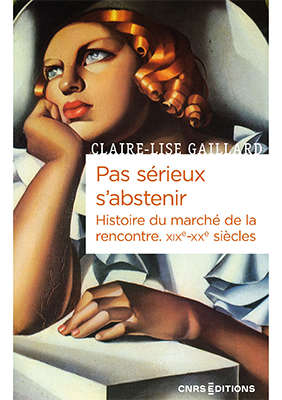Claire-Lise Gaillard

INED post-doctoral fellow Claire-Lise Gaillard is using an extensive corpus of personal ads in her current research project.
(Interview conducted in December 2022)
What was the subject of your doctoral thesis?
My thesis was on the history of the matrimonial market over the nineteenth and twentieth centuries. In the wake of the French Revolution, a new profession developed: commercial matchmaking. Marriage agencies developed out of business agencies serving a bourgeois clientele through the management of property sales, rentals, travel arrangements, or administrative affairs: there were so many such agencies in Paris during the July Monarchy that to compete successfully they began offering new services. I worked to reconstitute the history of that stigmatized profession, mocked in nineteenth-century vaudeville theaters and judiciary chronicles. By studying the accounts of a major Paris agency, I was able to show that these commercial operations at first offered their services to a male clientele only, to whom they sold the means of accessing potential spouses above their own socio-economic condition. Without the agency’s mediation, the women in question would have been beyond clients’ reach. Meanwhile the women themselves knew nothing of the transaction. During the Third Republic, this market made use of the emerging personal advertisements market to reach a less Parisian, less bourgeois clientele, one in which women had somewhat greater maneuvering room.
What do we learn from your corpus of personal ads?
Personal ads gave me access to the history of life partner choice and the stages by which it was individualized. Matrimonial ads are a particularly rich and effective source for understanding the wishes and expectations of men and women seeking a life partner. Quantitative analysis of three sets of such notices published over the nineteenth and twentieth centuries led me to qualify the notion that marrying for love triumphed at the turn of the century. In fact, affection economic interests remained fundamentally entwined over the period, and the vast majority of people continued to prefer endogamous unions even after World War I. Evidence of a change in this predilection is more to be found in discourse than practice: being of similar social condition was no longer openly claimed to be the absolute condition for a happy match. The weight of the family in a given marriage diminished with the importance of the inheritance issue. But the greater the economic implications of the match, the tighter and more enduring the grip of family social situation. My sources strongly suggest that women did not become fully active participants in spousal choice during the interwar period as there can be no doubt in these texts about the distribution of roles: the man’s prerogative was to choose, the woman’s to consent. This structural inequality powerfully affected matrimonial pretensions and therefore marriages.
What is the subject of the recently published book you coedited, Histoire de célibats [A history of singlehood]?
My colleague Juliette Eyméoud, who holds a PhD in modern history and I coedited a collective work entitled Histoire de célibats. We wanted to examine singlehood longitudinally from the late Middle Ages to the twentieth century. The definition of that term varied by period but also by individual’s age, gender, or social class, so we chose to follow out ten life histories to measure the effects of singlehood and its gradual stigmatization over the affective, sexual, occupational, social, and family trajectories of the individuals concerned. The contributing authors thus agreed to think in terms of case studies, presenting historically and socially situated trajectories that open avenues for a history of single people that remains to be written, at least in part.
What subject are you currently researching at INED?
For my post-doctoral fellowship I’m studying how couples’ selection criteria evolved in the twentieth century. I compare two key moments: the interwar period, when the idea of sexual entente in marriage was enshrined, and the 1970s, marked by politicization of intimate relations and falling marriage rates. Through diachronic and synchronic analyses and comparisons of four sets of personal ads, I’m working to understand how partner selection criteria were reconfigured by the degree to which the relationship was socially instituted. The question underlying my research is, when love relationships broke free of the marital framework, did this signal the emergence of a free market of desires?

